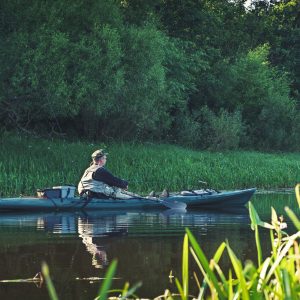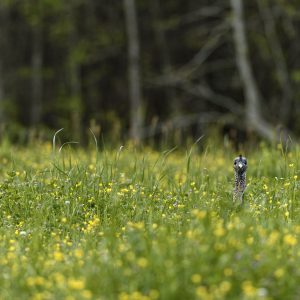Lace up your boots, grab a walking stick, and hit the woods. There are few more rewarding activities for a sportsman than combing through late winter or early spring woods searching for whitetail deer antler sheds. No, you won’t be taking a “grip-n-grin” photo of a quarry you nailed with bow or firearm, but you will be doing the next best thing -touching and admiring that animal’s headgear.
In some ways it’s more exciting than hunting with bows and guns because you are always on the go, always up and moving, searching for the cast-off head-gear that bucks no longer need. That stands in sharp contrast to fall hunting seasons when the most productive tactic almost always involves sitting rock-still in a blind or perched in a tree for long hours of watching.
Reasons to Search for Deer Sheds
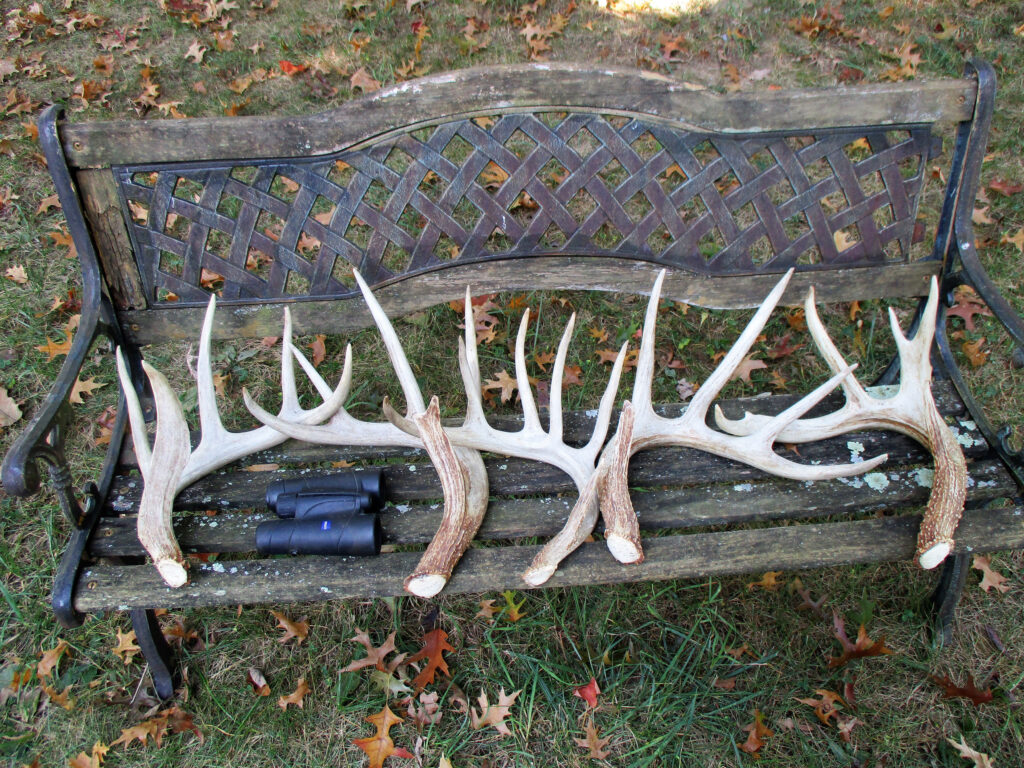
There are many reasons to hunt for sheds. Let’s start with the most basic: it’s just plain entertaining. It brings a thrill like no other when you stumble upon half of a buck’s rack after hours or sometimes days of searching.
Sheds also tell you valuable information about which deer survived the season and where they were during late winter when they dropped the antlers. This can be invaluable for plotting out the best late season hunting locations and strategies for next year. Many people rely almost exclusively on trail cameras for this information these days, but for some of us, there’s also much to be said for finding the actual headgear an animal cast off, for hands-on examination when possible.
Finding a shed also allows you to more closely estimate specific animals’ ages. This isn’t determined by the number of points or spread in most cases, but rather by the length of main beam and mass measurements – the two elements most closely correlated with the age of an animal.
Here’s another bonus of shed hunting. When you’re out walking those fields and climbing those hills you’ll also be getting yourself in shape for the coming turkey season and food plot planting. Lots of us tend to get a bit “slack” during the period from the last day of deer hunting until fishing and turkey hunting arrives. Searching for sheds will help you prevent those pot guts and atrophying muscles from ever happening.
The main reason, though, to hunt for sheds, at least for me, comes back to the insights it gives you into your local deer herd’s favorite locations and behavior patterns. Look at shed antler hunting as both a sport and preparation for next year’s deer season. While you’re hunting for cast off antlers, you’re also scouting for sign that will help you determine the best ambush spots for bucks this fall as you decipher their bedding areas and travel corridors.
When to Start Searching for Sheds
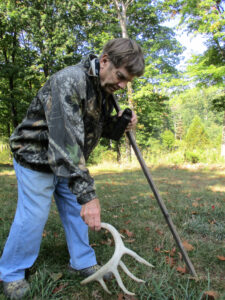 Deer in most areas lose their antlers sometime between January and the end of March. Soon after that they’ll be sprouting the start of next year’s racks. Occasionally a deer will drop its antlers in December and another may hold its rack until April, but January through March is the period for casting off the crown.
Deer in most areas lose their antlers sometime between January and the end of March. Soon after that they’ll be sprouting the start of next year’s racks. Occasionally a deer will drop its antlers in December and another may hold its rack until April, but January through March is the period for casting off the crown.
Sometimes I’ll just stumble upon the first shed and then start searching for more. You can also use your trail cam-eras to show when the first few bucks begin to drop.
If you start early, you may have to go back and search again if some deer haven’t shed yet, but this will give you a jump on finding the first bone to fall and allow you to claim them before other hunters do. And if you wait too long, chipmunks and mice may damage them. They’re attracted to the high levels of calcium, phosphorous and other minerals they contain.
On the other hand, if you live in a northern climate and bitter cold weather is still bearing down hard, consider putting off your search at least in their daytime bedding areas until milder conditions arrive to avoid further stressing winter-weakened animals.
Besides looking for antlers, you should also be scouring the woods for sign such as rubs, scrapes, tracks and droppings. Study the terrain and vegetation for natural travel funnels and take note of prime feeding and bed-ding areas. Information of this type is crucial for deciding where to hang stands or build blinds for next fall’s hunting season.
What Finding a Shed Means
You could find a shed anywhere in a deer’s home range, usually encompassing hundreds, if not thousands of acres. But the odds are good 90 percent or more of the antlers you discover are going to be found in one of three locations—1) bedding areas, 2) travel routes or transition corridors, or 3) feeding areas.
Bedding Areas
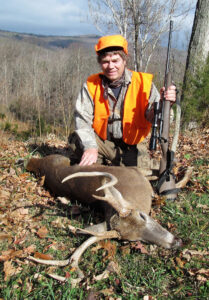 Unless it’s located in a winter feeding area or along a travel route, chances are good when you discover a shed; you have found part of the core bedding territory of the deer that dropped it. The thickest, most remote areas are the ones dominant, older bucks will claim. Overgrown swamps, conifer stands that block the wind and provide thermal protection, saddles in ridges, brushy hollows, creek bottoms, benches just down from ridge tops, regenerating clear-cuts, and overgrown thickets with dense shrub cover are the places to look for sheds left by bedding bucks.
Unless it’s located in a winter feeding area or along a travel route, chances are good when you discover a shed; you have found part of the core bedding territory of the deer that dropped it. The thickest, most remote areas are the ones dominant, older bucks will claim. Overgrown swamps, conifer stands that block the wind and provide thermal protection, saddles in ridges, brushy hollows, creek bottoms, benches just down from ridge tops, regenerating clear-cuts, and overgrown thickets with dense shrub cover are the places to look for sheds left by bedding bucks.
Find a shed in this type of habitat and you’ve likely pinpointed a great early season and late season stand location on the edge of that thick cover. At least that’s been my experience – the same rough, dense hideouts the bucks use in late summer and early fall are often hot again as the hunting season’s final days wind down during late December or January, after the rut concludes. It’s spot that has kept them safe thus far. These are often the same spots that serve as escape areas for bucks if you hunt in high-pressure situations.
Traveling Animals
If you find a good deer antler shed and it’s not in a thick, jumbled or remote bedding cover, chances are it’s on a route the animals use from that daytime bedding cover to evening or nighttime feed areas. This is also a valuable discovery and can be a prime fall stand site, especially if you locate a pinch-point or other restricting structure along the route. Using topography maps and aerial photos, try to figure out where that deer was moving from and heading to. A buck certainly will vary his travel patterns, but if you find his antler, you are at least on one key route he uses.
Exploit the spot where you discovered the shed as a center point and explore all around in every direction. Work in circles trying to trace back the buck’s movement towards his major bedding area. You may find the matching shed of the buck or locate another antler from an even older deer. Both during late summer/early fall and in late winter, bucks will typically be bunched up in small groups or occasionally alone.
Feeding Fields
When you locate a shed along a travel route or transition corridor, start looking downhill from there in elevated terrain or towards more open fields and try to predict where the animal was heading to feed. This might be an acorn flat, an orchard with remnant fruits, or an area with succulent forbs and browse. More than likely; however, it means an agricultural field with left-over crops or a food plot. Whichever of these potential feed areas you discover follow the tracks and/or rubs to see where they lead.
You want to know which prime late season feeding sites your deer are using. And you’ll stand good odds of finding another shed or two further along the route or at the feeding site itself.
The number of sheds you find in these areas seems to vary a lot from region to region and even among specific properties. Some “shed heads” find a lot of antlers at the actual night feeding areas; others only a few. I have to admit, I’m in the later camp, finding perhaps 15-20 percent of sheds I locate in these areas. Another 40-50 percent I pick up at bedding spots, the remainder mostly along travel routes.
Keep Meticulous Records
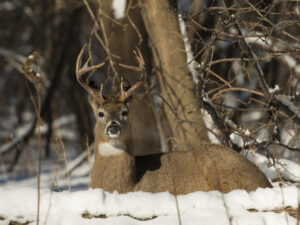 To get the most out of shed hunting, keep thorough records of what you find. Write down the antler’s circumference measurements, beam length and the number of points in a notebook, or simply score it, and also take and print out a photo of it. Record its location or mark it on a topographic map or sketch of the property so you have the exact spot pinpointed.
To get the most out of shed hunting, keep thorough records of what you find. Write down the antler’s circumference measurements, beam length and the number of points in a notebook, or simply score it, and also take and print out a photo of it. Record its location or mark it on a topographic map or sketch of the property so you have the exact spot pinpointed.
Also calculate the score of the antler and try to estimate its age, using information from any trail camera images you may have of that particular buck. All of this can then be scoured over and analyzed before next fall to help you decide which bucks to pass for another year or two, which ones to try for, and where the best ambush spot is likely to be to accomplish that goal.
Technique
The best method I’ve found for successful shed hunting is to try to work methodically in a grid pattern. That way you don’t overlook any habitat. Work parallel, walking along side hills or benches. Then move up 30-80 yards (depending on the thickness of the habitat) and work back the opposite direction.
If you work “up and down” you’ll waste a lot of energy. Years of grouse hunting in hilly country taught me that approach. Also consider re-working through areas that look especially good or have produced sheds in the past. Approaching from a different angle may make the antler stand out more. Look for the curve of the main beam, points jutting up through remnants of snow, or the glint of sunlight on the rack.
“Drives” also offer a fun way to discover sheds. Get several friends or relatives together and work as a group like you were conducting a push during hunting season. Spread out evenly so you won’t miss areas. This way it becomes a social event and everyone can share in the excitement when a shed is found.
Finally, consider bringing “man’s best friend” along. Many dogs will enjoy the activity and can easily be trained to help you find sheds, in fact, now days some choose to train their dogs specifically for this task. Just let him know YOU get the sheds, not him!
Try These Productive Shed Hunting Spots
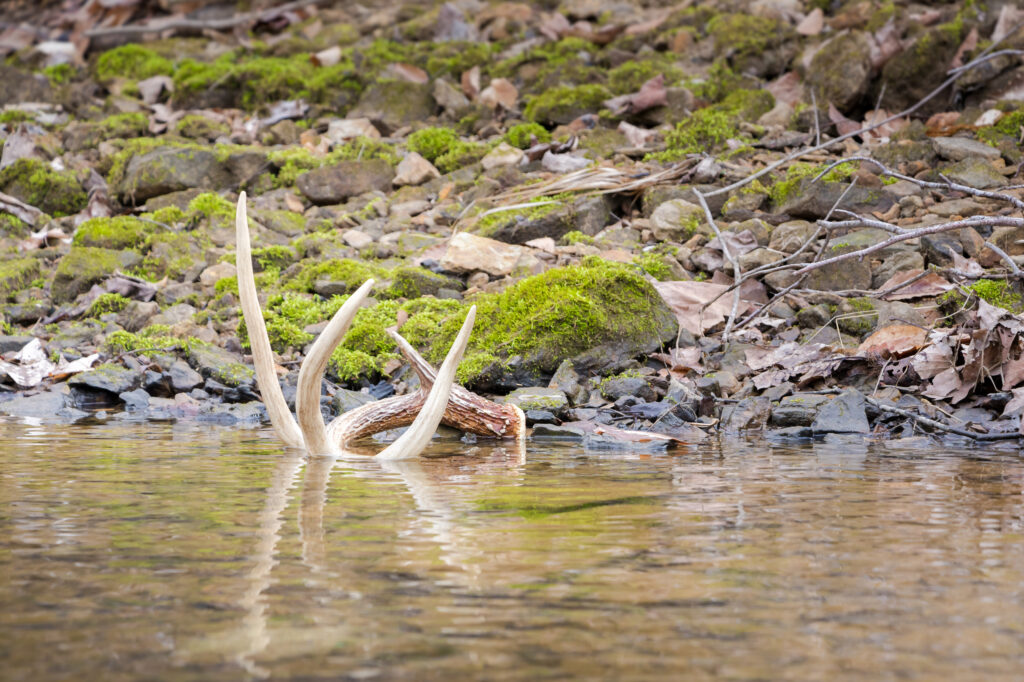
Good spots to search for sheds include heavy cover near food plots, feeding fields, swamps, conifer stands, brush-choked hollows, saddles in ridges, benches, draws, creek bottoms and islands in rivers. Sometimes you’ll find sheds in cover so thick you can barely walk through it. Other times you’ll locate them easily in open feeding areas where the animals probably dropped them at night. Areas that have been burned recently are great since the sheds literally jump out at you against the blackened back-ground. South and southwest facing slopes are often productive since bucks can soak up the rays of after-noon sun there.
Persistence Pays
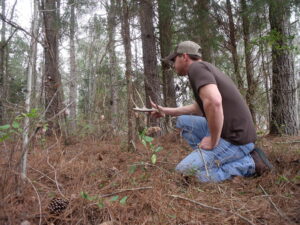 To succeed at this sport, the best advice most experts give is to simply cover lots of ground and look very carefully. Remember, this isn’t a race. It’s not how fast you walk, but how carefully you scour the ground. Obviously, it also pays off best to concentrate your efforts in the likely places mentioned above.
To succeed at this sport, the best advice most experts give is to simply cover lots of ground and look very carefully. Remember, this isn’t a race. It’s not how fast you walk, but how carefully you scour the ground. Obviously, it also pays off best to concentrate your efforts in the likely places mentioned above.
Tip: If you have a choice, hunt during a light rain or on cloudy days: the antlers show up better then. If you have to hunt during bright, clear weather, keep the sun at your back and wear polarizing sunglasses.
Finally, two items I like to bring on every shed hunt are a walking stick and a good pair of binoculars. The optic save energy for when you see something 75 yards away but aren’t sure it’s worth walking over to check out. I can’t tell you the times that “something small” turned out to be a portion of an antler that I would have otherwise walked past.
Don’t be Greedy!
It’s important to keep your hopes in check when you hunt for sheds. Don’t anticipate finding an arm full of antlers. If you pick up two or three on a half-day outing, consider it a successful shed hunting expedition.
Some days you might find half a dozen, other days zilch. Once you find your first deer antler, though, chances are you’ll make shed hunting a regular part of your outdoor activities.
Shed hunting is a great way to introduce youth to outdoor sports and the world of whitetails, it’s great exercise and something to do with your friends and family that will cure cabin fever. And best of all, when fall arrives you’ll find that what you learned from searching for sheds has made you a better hunter.


